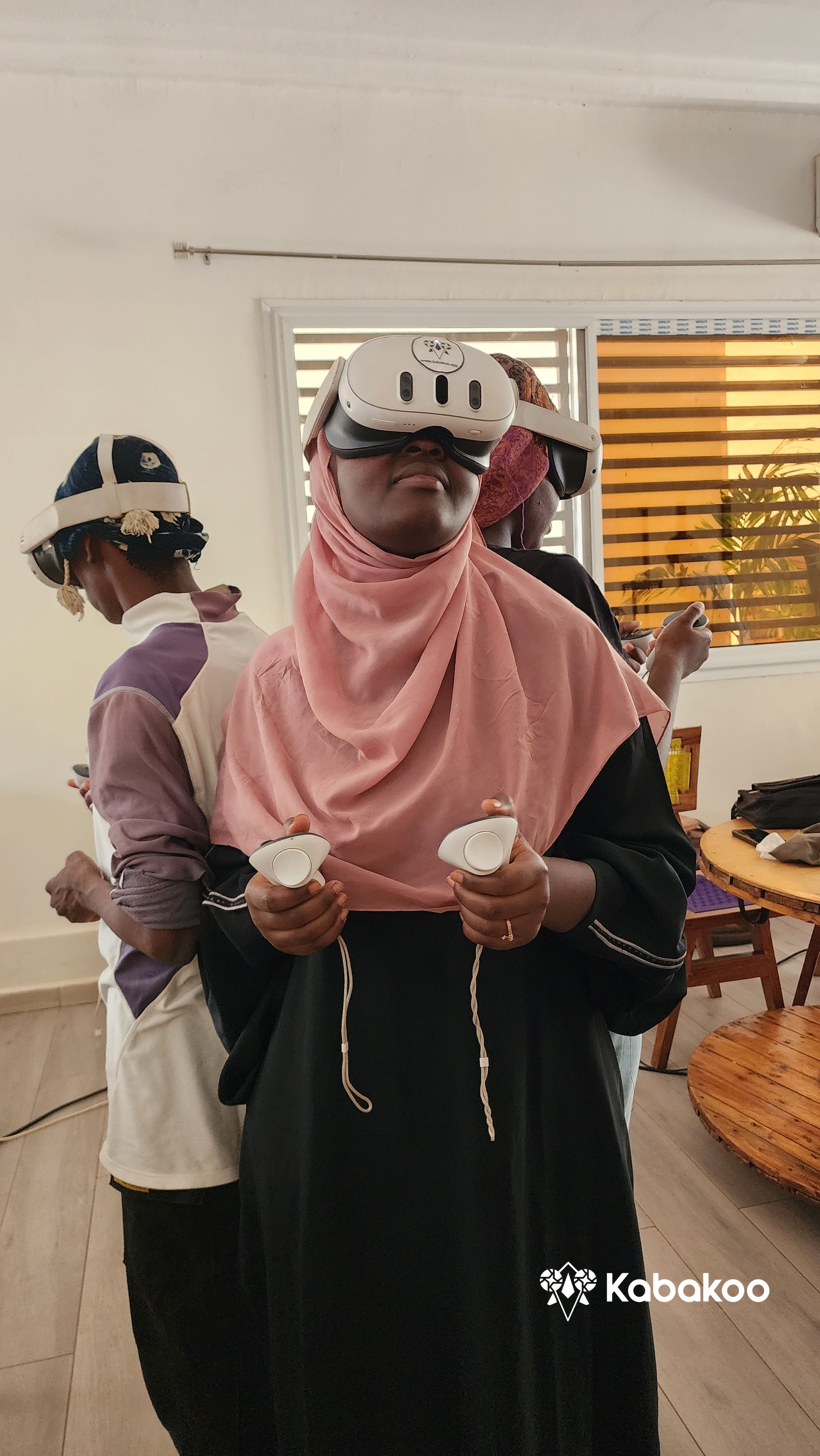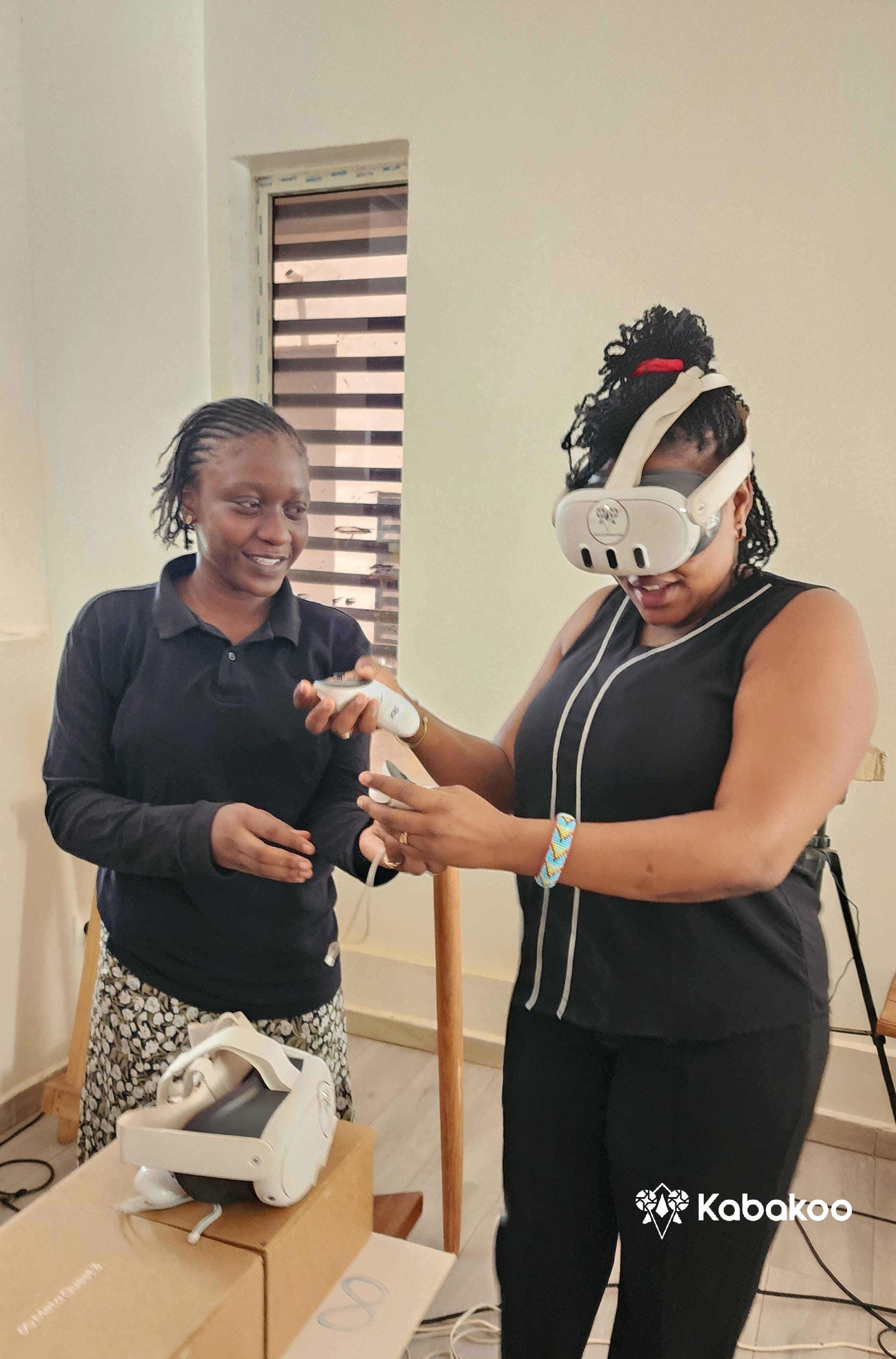Welcome to our April newsletter!
As usual, let’s start with some grooves.
🎶 Our song of the month is Manjanja Funk by Ekambi Brillant. Give it a try if funky bass lines are your jam.
What are we building?
Kabakoo designs and scales evidence-based pathways for West African youth, integrating AI, community, and cultural insights to foster the mindset and skills essential for building productive livelihoods and driving systemic change in informal economies.
☀️ April 2025 Highlights
This month’s edition is packed with exciting updates about our impact data, progress with our Bambara AI initiative, and inspiring XR projects from our learners.
New data confirms Kabakoo’s impact and clear ROI
Our latest survey delivers clear, compelling evidence: Kabakoo is not only shifting mindsets, but also getting youth to significantly improve their economic odds. This analysis compares individuals exposed to Kabakoo’s program to a control group, ensuring a clean counterfactual and reliable findings. The findings presented are from our initial pilot cohorts (N=154), which ran four years ago.
As observable below, there is a clear difference in the income trajectory of the Kabakoo learners (TG for treatment group) versus the one of the controls (CG for control group).

A deeper analysis of the 2025 income distribution reveals that a significantly larger share of participants in the Treatment Group, 61.3%, now earn more than 150,000 FCFA (≈ USD 245), compared to just 26.9% in the Control Group, a difference of about +34 pp. TG participants are also more represented in the highest income brackets, while CG participants remain more concentrated in the lower income categories.

ROI at 36 months
Between 2022 and 2025, Kabakoo learners experienced a notable increase in average income category to 3.87 compared to a marginal change for the Control Group, from 3.00 to 3.12. This represents a +1.97 category gain for TG relative to CG.
Assuming a conservative estimate of 50,000 FCFA per income category, based on the observed average income gap, this equates to a monthly income gain of 98,500 FCFA (≈ $161 using an exchange rate of 610 FCFA/USD).
To convert this into present value over 36 months, we apply a present value interest factor of an annuity of 31.17, derived from a 10% annual discount rate. This yields a gross present value gain of $5,018 per TG participant!
Accounting for potential self-reporting bias, we apply a 50% haircut, resulting in a net gain of $2,509. With a program cost of roughly $400 per participant, this leads to a final ROI of 6.3 meaning every $1 invested generates $6.30 in net economic benefit over three years.
Investment in productive assets
We also analyzed the types of investments made by individuals from two groups, TG and CG, to improve their professional lives. The goal is to identify trends in how each group allocates resources toward digital tools, training, mobility (transportation), and other areas of professional development. The data is based on self-reported purchases or investments made to enhance professional capacity. Respondents could select one or more categories.

As displayed in the chart above, Kabakoo learners are also more likely to invest in productive assets like training (51% vs. 32%) and machines (17% vs. 7%). Most strikingly, Kabakoo learners are much less likely to make no professional investment (2% vs. 14% in the control group).
This new wave of data allows us to quantify the economic impact of Kabakoo in concrete terms upon a longer period of time. An ROI of 6.3 is a compelling evidence of the cost-effectiveness of our approach, and our current work on WhatsApp-based distribution will even increase our impact by dramatically decreasing program costs.
One year of the Bambara AI Mentor: learning, listening, and looking ahead
We are celebrating a meaningful milestone at Kabakoo: it’s been one year since we piloted our AI mentor in Bambara (Bamanankan), one of the major West African languages. Bambara, also known as Bamanankan is the lingua franca for millions in Mali, Burkina Faso, Côte d’Ivoire, Guinea and Senegal. This initiative, 100% designed and piloted in Mali by our team, reflects our commitment to building learning technologies that are inclusive, culturally grounded, and aligned with the real-life contexts of our communities.
The data is nuanced. During Bamako.AI #2 in May and June 2024 following the launch, interaction with the mentor peaked at 1,452 conversations, followed by 1,122 conversations one month later. Though engagement has since decreased significantly through 2025, ongoing activity shows the tool maintains a smaller but consistent user base. We are still far from product-market-fit with the Bambara AI Mentor; and we believe we know why.
To better understand the impact and identify areas for improvement, we ran hands-on interviews with our learners; and we gathered valuable insights into how the Bambara AI Mentor addresses real community challenges :
- Why the Bambara AI Mentor matters to our community ?
Bambara is one of the most widely spoken languages in West Africa, and many learners prefer it for oral communication. However, they often find French easier for reading and comprehension. Interestingly, learners naturally mix Bambara and French in daily life, which reinforces the need for our system to support both languages seamlessly. Our bilingual approach (French text with Bambara audio) helps create more accessible, intuitive learning experiences.
- What challenges are we still working on ?
While we’ve made impressive strides—reducing our model’s Word Error Rate (WER) from 0.98 to 0.64 using OpenAI’s Whisper architecture—there’s a significant data gap. With only 10 hours of high-quality Bambara audio data, we need an additional 90 hours to build a truly useful and scalable model.
With the lessons learned over the past month, we are aiming for several key improvements:
- Scaling the model, by finding innovative ways to gather quality voice data to reach even more learners across the region.
- Improving accuracy to ensure clearer and more helpful responses.
- Supporting multilingual use, reflecting how the youth we serve actually communicate. The chart below clearly shows this multilingual pattern. While discussions with the AI Mentor about entrepreneurship and education dominate both languages, Bamanankan conversations tend to focus on local & cultural topics, and tech talk happens mainly in French.

We remain committed to exploring ways to access the needed resources to bridge the data gap via strategic partnerships and philanthropy. This Bambara AI Mentor isn’t just about building another chatbot. It’s about creating learning systems that reflect who our learners are and how they live. By doing so, we hope to meet our goal of serving 1 million learners by 2030.
Pioneering XR at Kabakoo: A celebration of creativity and vision
In April, our learners proudly showcased their XR creations during a vibrant Virtual Reality Fest.

From a VR game based on a Malian folk tale to a meditation app for deep relaxation, a basketball experience, a virtual museum, and even a flying AI whale—our learners’ imagination truly blossomed. These projects are the result of countless hours of work, with some learners coding late into the night to bring their visions to life. Watch our learners present their projects here.
The event was more than just a tech demo or VR Fest. It was a celebration of creativity, dedication, and what becomes possible when local knowledge meets cutting-edge tools. The joy was palpable: from a staff member getting hooked on Mamadou’s immersive folk tale to the crowd’s laughter at Moussa’s flying whale.
We are proud to be doing pioneer work on XR, not just as a tool for entertainment, but as a powerful learning medium for storytelling and value creation. And this is only the beginning.
Kabakoo Faces
(With over 34 821 registered learners, each month we spotlight a member of our vibrant community.
Amadou’s story shows the power of regained agency and the right learning system. Coming from a Madrasa school background with limited exposure to French and English, he says that digital technology once seemed like an insurmountable challenge, until he discovered Kabakoo.
As a Kabakoo learner, Amadou gradually developed the ability to address some of his personal challenges, gained trust in himself and has transformed his journey into entrepreneurial success. Today, he generates revenue by creating websites, holds a position at a travel agency, and continues to grow his digital venture. Hear himself describing this transformation with his own words here.

Random news 🤖 🌮 🇲🇽
We are excited to announce that our Co-Founder and Chief Learning Officer, Yanick Kemayou, is attending REAL ML next month in Mexico, a collaborative workshop and network of leading figures in the areas of AI and algorithmic accountability. We are delighted to share our work on building AI-tools for Bambara on this platform. And we look forward to connecting with both familiar faces and new friends. Most importantly, we are eager to collaborate in making AI work for the youth in West Africa.
Thank you for reading to the end! 💜🧡
Michèle & Yanick











